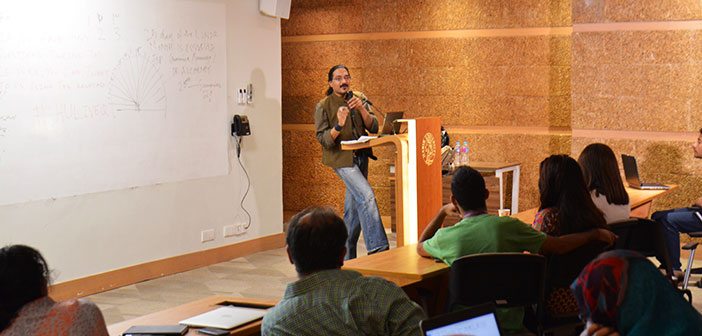Dr. Hasan Ali Khan explores the ancient Abjad system of numerology and how it impacted the sciences and arts in the Muslim world
HABIB UNIVERSITY, APRIL 27: Habib University’s School of Science & Engineering rounded off its Public Lecture Series for the ongoing semester by inviting one of the most popular professors from the School of Arts, Humanities & Social Sciences for a talk that explored the relationship between an ancient ‘science’ and art.
The speaker, Dr. Hasan Ali Khan, was awarded a doctorate from the School of Oriental and African Studies, University of London, for his research on the beliefs, history, and architecture of the Suhrawardi Sufi Order in Multan and Uch from 1200 to 1500 A.D. He has previously taught at the Aga Khan University in Karachi and the Indus Valley School of Art and Architecture.
His talk – titled “The Abjad System in the Sciences and Arts: Its Rise and Fall” – examined the surviving historical evidence on the use of the Abjad number system in the Muslim world. He talked about how the varied applications of Abjad by Muslim scholars contributed to both the development of the hard sciences as well as unique pieces of poetry and culture. “It was a system that is today lost to us because of Modernity, but [was]known to most for centuries; many of the things the Modern use, stemmed from this system that the Orient gave to the world,” read the abstract of the talk.
The name “abjad” (abjad أبجد) is derived from pronouncing the first letters of the Arabic alphabet in order. It is a type of writing system used widely in pre-Modern times by both scientists and artists to create scholastic or aesthetic works that were in harmony with the cosmic order of the university. The system prescribes a numeric value to the 28 different alphabets used in Arabic in a series of eight symbolic words (the first of these words being abjad, composed from the first four letters of the alphabet). The number 28 corresponds to the number of days in the Islamic calendar, which follows the lunar cycle.
During his talk, Dr. Hasan Ali Khan described, to the audience’s fascination, how this system was used to lay the foundations of the city of Cairo in 969 C.E. The traditional name of the city – ‘Al Qahirah’ – was chosen for a specific purpose: derived from one of the Names of Allah that translates roughly to ‘The Vanquisher’ in Arabic, it would recognize a city that would vanquish the enemies of the Fatimid Empire. True to the nuances of the abjad system, the city’s founders chose the timing of the ascent of the planet Mars (‘Al Najm Al Qahir’) to coincide with when the city’s first foundations were laid.
Dr. Khan utilized examples like these to explain how deeply pre-Modern scholars invested themselves in the abjad system to conceptualize and create things that could reflect and internalize what they saw as the divine order of the cosmos. Sadly, this fascination with the abjad system was gradually lost in mankind’s march to modernity, and very few scholars with expertise in abjad now remain in the world.




